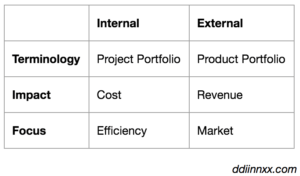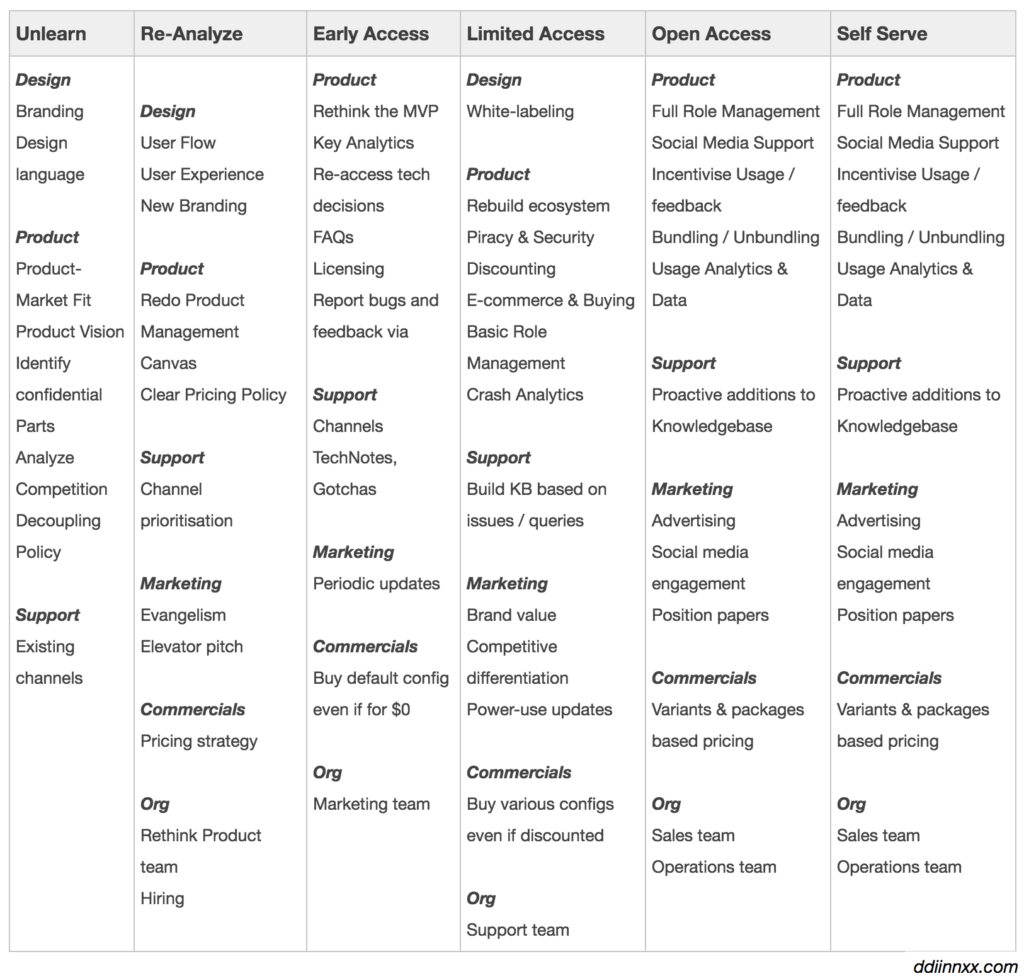Exploring how to take a product that been built for internal use by a company to market. Starting with why it could / should be done, discussing the stages in which this can be done, specific tasks for a Product Manager and finally various tasks for various team.
1. Intro
1.1 Internal v/s External

2. Why
2.1 Why Take To Market
- Revenue Potential
- Employee Morale
- Leadership
- Thought
- Technology
- Product
- Design
- Domain
- Engineering
- Practices
2.2 Five Questions to Start With
- Who else will buy this?Names of likely buyers and categories of buyers. The reason ‘else’ is emphasized is highlight that there is already one customer, your own org.
- What all options will they reject to buy this?Similar products or option to custom-build
- For what key benefit, you think, they will pay?The USP / Key Value Prop
- How much and how do you think they will pay for this?First take on Pricing and pricing model
- Why would your org support this effort?A powerful reason
3. How
3.1 The Golden Logarithmic Spiral
First thing to keep in mind:

The complexity in each stage of this process will increase logarithmically. Remember this spiral very well.
3.2 Six Stages of Business Rollout
External Product will be exponentially more complex compared to in-house version.

The left side of this cup implies is that a we climb down from what has been built/learnt till now, unlearn, the complexity will decrease.
However, as we reanalyze and then start the process, the complexity will grow exponentially.
The stages:
3.2.1 Unlearn

Unlearning is very important. In any future crisis, resorting to what worked earlier can be disastrous. Doing experiments anew is important.
3.2.2 Re-Analyze

Starting with 5 Questions mentioned earlier, re-analyze the product, its reason and benefits with whole market in view.
3.2.3 Early Access

Good time to test many hypotheses.
3.2.4 Limited Access

Less Complexity compared to to where you are now.
3.2.5 Open Access

Much more Complexity than you could ever face in-house. Plan for it, but no point guessing/estimating this and beyond. Thus, take lean approach.
3.2.6 Self Serve

Plan for it, but no point guessing/estimating this and beyond. Thus, continue to take lean approach.
3.2.7 In Detail

3.3 Seven Tasks for the ProMa
- Get Design team to work on branding and reassess the user flow and experience
- Get Product team to redo the Product Management Canvas
- Get Quality team to ensure the product will work well them opened up
- Get Security team to analyse the risks as product is opened up
- Get Marketing team to deliver collaterals, articles, blogs, ads, etc
- Get Support team ready to help users as if their lives depended on it
- Get Sales team going and bringing on booking / revenues
3.4 Twenty-Five Actions for the Teams
3.4.1 Design
1. Design an independent branding and design language
2. Rethink user flows and user experience based on user research as 100% of new users may not be directly accessible
3.4.2 Product
3. Rethink your MVP
4. Redefine product vision
5. Take control of Roadmap and break free from shackles of Product Sponsor and early advocates
6. Remove confidential analysis, techniques and flows
7. Re-assess product-market fit
8. Take competition more seriously and not just source of ideas
9. Revisit rejected partners and rebuild an ecosystem
10. Add Role Management to accommodate for Admins and Super-Admins
11. Re-access tech decisions on tools, stacks and methods
12. Start saying NO to requests from Product Sponsor or early users
13. Consider licensing
14. Consider threat of Piracy and security breaches
3.4.3 Feedback, Support, Marketing & Communication
15. Build searchable and easily navigable Knowledgebase to enable self-discovery
16. Add reporting of bugs, providing feedback, request support from within the product
17. Add reporting of bugs, providing feedback, request support using social media
18. Incentivise / reward communication from users and partners
19. Reach out and market using social media and do not hesitate to advertise
3.4.4 Business & Commercial
20. Add ‘buying’ of product, even if it is for $0
21. Establish a pricing/discounting/packaging policy
22. Retrain team to focus on revenues and setup efficient revenue tracking
23. Making ‘buying’ or e-commerce via your product simple
3.4.5 Organisation
24. Get a dedicated team
25. Get branding, support, marketing and sales teams in place
4. Best Practices
4.1 For Open Sourcing
- Technical Communication
- Version Control, Document Management, and Distribution
- Quality Assurance
- Build and Test Management
- Project Management
- Knowledge Management
4.2 For Commercialising
- Clear pricing policy
- Easy to understand licensing policy
- Easy to report bugs and provide feedback
- Continuous security analysis and piracy protection
- Easy to use e-commerce and buy
- Ability to define roles and grant permissions
- Self-discovery via knowledge management
- Support (free and paid variants)
- Enables 3rd parties to build products or provide service on top of your product
- Analytics



